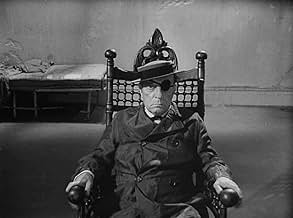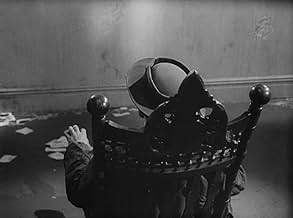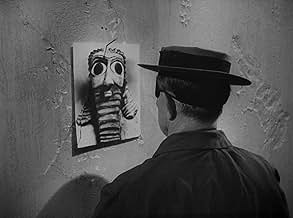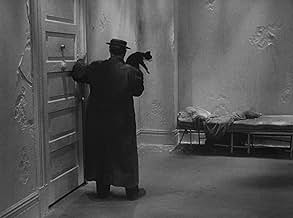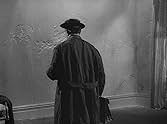Añade un argumento en tu idiomaA twenty-minute, almost totally silent film (no dialogue or music, save one 'shhh!') in which Buster Keaton attempts to evade observation by an all-seeing eye. But, as the film is based arou... Leer todoA twenty-minute, almost totally silent film (no dialogue or music, save one 'shhh!') in which Buster Keaton attempts to evade observation by an all-seeing eye. But, as the film is based around Bishop Berkeley's principle 'esse est percipi' (to be is to be perceived), Keaton's ver... Leer todoA twenty-minute, almost totally silent film (no dialogue or music, save one 'shhh!') in which Buster Keaton attempts to evade observation by an all-seeing eye. But, as the film is based around Bishop Berkeley's principle 'esse est percipi' (to be is to be perceived), Keaton's very existence conspires against his efforts
- Dirección
- Guión
- Reparto principal
Reseñas destacadas
Keaton was mystified by this script, too, as by "Godot", but wanted the money. He suggested several comedic bits be added, because he thought the whole thing would be less than five minutes. In New York, he wanted to use one of his flat hats rather than the bowler Beckett had written in, and Beckett immediately agreed.
The film was shot in mid-summer in a very hot New York, each day over 90 degrees. Keaton (age 69, and not in great health: he died less than two years later) never complained as he had to keep running along that brick wall in the heavy overcoat.
It was Beckett's only visit to the U.S., and he never got outside of New York, and left the U.S. as quickly as possible.
This experimental short was written by Samuel Beckett, and directed by his frequent stage collaborator Alan Schneider. The actor they cast in the lead was not their first choice for the role, but his haunting presence is a key reason why this film called "Film" is still remembered and frequently screened today: the old man is 68 year-old Buster Keaton, who at this point in his career was more commonly seen in TV commercials, variety show guest shots, and occasional movie cameos. This was not at all a typical gig for Buster, nor was it a routine project for Beckett, who was more inclined to write for the stage or radio. Beckett had wanted to work with Keaton several years earlier, when he offered him the role of Estragon in the American stage premiere of "Waiting for Godot," but Buster turned it down and the role went to Bert Lahr. It's said that Buster didn't understand "Godot" and had misgivings about this script as well, but for whatever reason he agreed to star in Beckett's first movie. It's a good thing, too, for even with his face hidden he brings dignity, comic nobility, and the weight of his personal history to the proceedings. Keaton represents his era, carrying the mantle of the battered but unbowed silent clown in this all-but-silent movie. Aside from a single sound effect (a whispered "Sh-h-h-h!") the soundtrack is entirely silent, while the grainy black-and-white stock used for filming is evocative of early cinema. What happens here is not really suggestive of Buster's own early work, but there is a beautifully characteristic sequence when the old man tries to put out his dog and then his cat, only to have each animal slip back in as he attempts to put out the other. Both Beckett and Schneider pronounced themselves more than pleased with Keaton's performance: the latter called him "magnificent."
My reaction to this movie has changed with the passage of time. When I first saw it years ago I found it interesting, but also kind of exasperating; I was frustrated I couldn't see Buster's expression. Now I'm struck by the film's directness and simplicity, and recognize that even a glimpse of the old man's face along the way would kill the impact when the moment of truth finally arrives. Samuel Beckett told an interviewer that the movie was "about a man trying to escape from perception of all kinds -- from all perceivers -- even divine perceivers." In between takes on the set near the Brooklyn Bridge the lead player told a reporter something similar, summarizing the theme as "a man may keep away from everybody but he can't get away from himself." I can't say it better than that and I'm not going to try. I'll simply note that we can be grateful Buster Keaton agreed to take part in this unusual project, a seemingly unlikely collaboration that in my opinion has aged beautifully.
This is a homage to Buster Keaton by Samuel Beckett who is playing with the ideas of subject and object in a world where perhaps we have no control over who is doing the watching. Beckett had been influenced a great deal by the genre of comedy and acting that Keaton personifies. Many of his books and plays feature tramp-like, down-and-out characters and he uses the physical comedy routines of vaudeville and silent films of the early 20th Century in many of his works. He and Keaton both share the idea of man thrown into an uncaring world where they are left alone to survive among its absurdity.
However later Beckett stated : "Buster Keaton was inaccessible. He had a poker mind as well as a poker face. I doubt if he ever read the text - I don't think he approved of it or liked it. But he agreed to do it, and he was very competent." Buster had turned down overtures from Beckett before, but he was in debt, and the story is that his wife talked him into it.
Note actor James Karen as a reverend in the alley towards the beginning. Karen worked with Buster Keaton in touring productions of the comedy "Merton of the Movies" in the 1950s.
¿Sabías que...?
- CuriosidadesThe story of making "Film" was the basis of a play "The Stone Face" by Sherry MacDonald. The play was read in Orlando at the 2006 New Playfest, and work shopped at the 2007 New Playfest.
- ConexionesFeatured in Zomergasten: Episodio #3.3 (1990)
Selecciones populares
Detalles
- Duración20 minutos
- Color
- Mezcla de sonido
- Relación de aspecto
- 1.37 : 1
Contribuir a esta página



